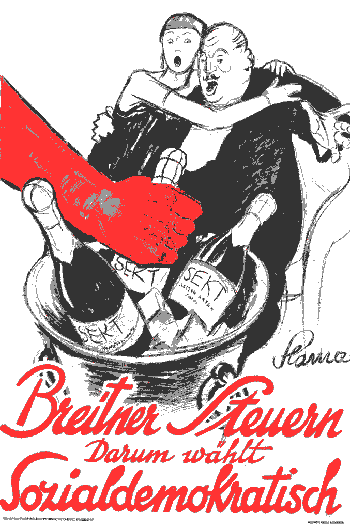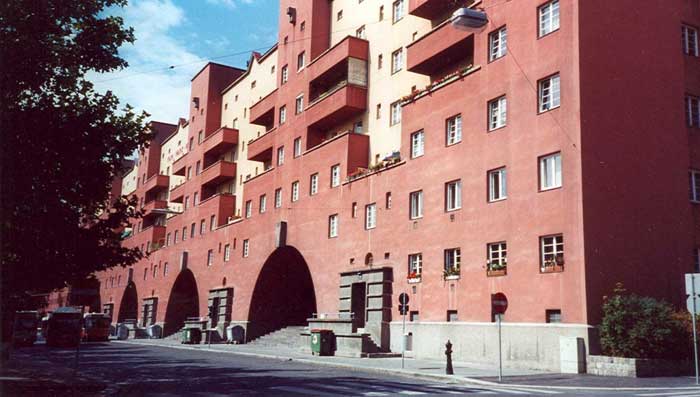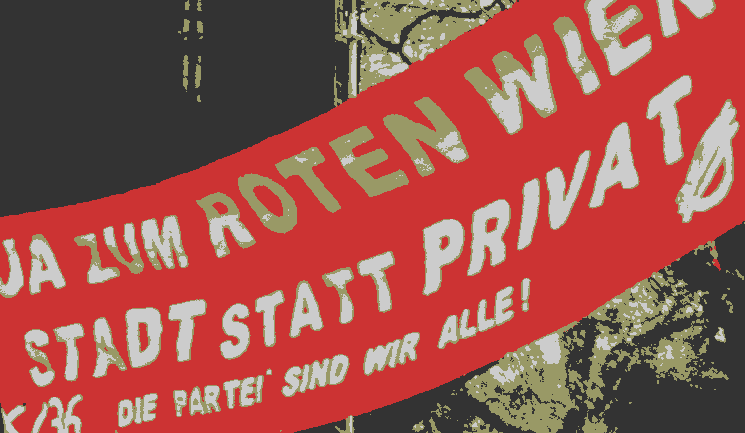I)
All right, class. Repeat after me:
Austria is not Germany.
Very good. Now repeat:
Red Vienna is not Weimar Germany.
I know. It’s confusing: Austrians and Germans speak the same language, more or less; both countries were defeated in World War I; both survived a massive economic meltdown; both harbored extraordinary movements in art, architecture, and thought; both, Red Vienna and Weimar Germany, were wiped out by the rising fascist tide. The difference is, Austria (or Vienna at least) was the site of a systematic and remarkably successful effort to build a socialist society, a lesson for those of us who see, once again, a need to move beyond the failed models of capitalism.
The 1919 beta version of the Crisis of Capitalism (they’ve all been beta versions so far) followed the collapse of the German Reich and the Austro-Hungarian Empire after World War One. Power fell by default to the various socialist parties that had resisted the War in its last years, and for a brief moment it seemed the Bolshevik revolution would spread beyond Russia. Yes, my friends: the hills were alive with the sound of muzhiks; but in Germany the heirs of the reformist Socialist Party crushed the Spartakist revolution; in Austria the Marxist leadership, the "Austro-Marxists," sidestepped the opportunity (or the threat) of a Russian-style People’s Republic, thanks to their own shrewd evaluation of the particular historical conjuncture.
"Down with Capitalism! Down with Fascism! Down with Oppression!" Socialist Party Insignia.
By 1919 Austria had become what it is today: a tiny country shrunk down from a huge dismembered empire. Not even that: today, Austria consists of Vienna, roughly 2 million inhabitants, plus the rest of the country, roughly 8 million: numbers and politics haven't changed much over the past ninety years. Politically, it’s as if you’d stuck Manhattan in the middle of the Bible Belt. Vienna is multicultural, cosmopolitan, left-leaning, with a restrained fashion sense; the "Blacks," as the non-Viennese are called (because of the dominance of Catholic priests) are religious, politically conservative, rural, and their idea of fashion is lederhosen and dirndls. A Soviet-style regime in Vienna would have been starved or militarily crushed, as happened in Bavaria and Hungary—not to mention the fashion statements. The best the Socialists could hope for was a divided country in which the Blacks controlled the national government but Vienna itself had sufficient autonomy to develop along Marxist lines.
There is a subtle difference between the Austrian Socialists and the German Social Democrats who seized power in Weimar Germany: the Germans argued that Capitalism could be changed from within, and peacefully. The Austrians had fewer illusions, or maybe opposite illusions: they thought (or claimed, at any rate) that peaceful, incremental change was playing for time while establishing a non-capitalist society strong enough to resist when fascist reaction struck. Germans and Austrians were both were wrong: in Vienna the Red-Black conflict came to a head in July, 1927, after the acquittal in a provincial court of right-wingers who had fired into a worker’s procession. Riots broke out in Vienna, the Palace of Justice was sacked and burned, the police opened fire, and 84 demonstrators were killed. Rightly or wrongly, the Socialist leaders refused to call up the worker's militia; from that point on their political power declined until February, 1934, when the Black militias stormed the housing projects in the first military attack against European civilians by fascist forces. Five months later the Black chancellor of Austria was killed in an attempted Nazi coup. Four years later Hitler’s troops marched into Vienna. As Lenin put it (he had a pretty good head for strategy), "Violence is not a sausage you can pick up, hot or cold, at the Nosh-stand of History."
The Austro-Marxists had a second reason to reject the political model in which the "People" seize the means of production. For Marxists and capitalists alike the golden rule in the twentieth century was a forced march to industrialization (in Russia and third-world economies), or re-industrialization in countries like Germany. Unfortunately, most of the heavy industry in the Hapsburg Empire was located outside the new borders of Austria, not to mention the raw materials: it’s hard to nationalize the factories if there aren’t any factories left. Marx had warned that "the capitalist transformation of the production process is at the same time the martyrdom of the producers," and this could have applied equally to Weimar Germany or Hoover's America or Stalin's Russia. By turning away from the standard model of progress through industrialization the Austro-Marxists anticipated the post-industrial socialism of the 21st century.
II)
The Socialists barely touched the banking system, which was, and still is, tightly connected to rural interests; periodically, Austrian right-wingers get the upper hand in the Federal Government, then they drive the economy into the ground, then they get driven out again until the voters forget—sounds familiar? Nevertheless, Vienna's City Council concocted a workable solution to the impossible situation of a country (or at least a metropolis) near economic and social collapse. By 1920 unemployment and homelessness had surged. Many Viennese were camping out in the Vienna Woods, living on mushrooms. The Socialist response was a maximum emphasis on the improvement of housing, medical care and quality of life, including culture and education.
Free Child Care, Karl-Marx-Hof.

There was little the City Council could do to improve worker’s wages, which in any case were highly vulnerable to inflation and devaluation because the economy was so dependent on foreign trade; but by minimizing living costs the Socialists hoped to improve living standards while decreasing the perpetual creation of scarcity that capitalism feeds on: they opted for sustainability over expansion, redistribution over confiscation, social stability over technology-based increases in productivity. Health-care was free: the Municipality boasted that no newborn child need ever be swaddled in newspapers again. Libraries and swimming pools were built; workers got paid vacations. In the new housing projects rents averaged 4% of household income, though you could postpone payment if you were unemployed. Most important, the program was funded by taxes on luxury and on landlords commonly called Breitner Steuern, Breitner Taxes, after the City official who planned them; the rich called it Steuersadismus, "Tax sadism." Sounds familiar?
Drink the Rich! Vote Socialist!
 No doubt the capitalists would have liked it better if the infrastructure of Vienna had relied on bonds like most of America’s infrastructure. But then Vienna’s public transportation system, one of the best in the world today, might have ended up like New York’s. Talk of sadism...
No doubt the capitalists would have liked it better if the infrastructure of Vienna had relied on bonds like most of America’s infrastructure. But then Vienna’s public transportation system, one of the best in the world today, might have ended up like New York’s. Talk of sadism...
The housing program, however, was Red Vienna’s greatest achievement. In the short run, the architects Margarete Lihotzky and Adolf Loos designed temporary, easy-to build structures, the ancestors of the housing-the-homeless projects of today. (That's right: a gurl architect!) Eventually the Council built ten percent of Vienna’s housing stock, mostly in large projects that included communal baths, nurseries, libraries and green areas, following the old ideal of the Garden City. Lihotzky designed one of the first models for an "efficiency" kitchen—apartments were small. The cherry on the schlag is the Karl-Marx Housing Project, over half a mile long, built on the edge of the Vienna Woods and colored red, ochre, blue, with golden statues of heroic mommas and poppas here and there. Oddly, it’s the mommas that have raised the most criticism from purportedly progressive scholars. All those colors and statues are so....unmodern, you see, so culturally corny, so bourgeois. Give me a plain, boring, efficient Bauhaus box, now that’s revolutionary.
Karl-Marx-Hof Housing Projects.

III)
This raises a deeper question about the possibility of change: can culture be revolutionary? That is, can cultural change alone enable a given society (a given culture, if you'll pardon the ad-homonym) to move beyond capitalism? The Austro-Marxist bet was, that they could educate the working class to socialism, ensuring a gradual transition to a truly socialist, possibly communist, society, democratically chosen. Unfortunately it’s a question that can’t begin to receive an answer without questioning the applications of concepts like Culture or, in this case, Kultur and Zivilisation, not to mention the various German words for "education:" Bildung, Erziehung and so forth. Throw in the concept of Herrschaft des Proletariats, usually mistranslated as "Dictatorship of the Proletariat," because it’s not necessarily a dictatorship through brute force, it’s also a struggle to develop the thought-processes, word-range and culture of the new class in power. Some argue that by trying to turn the Viennese working class to bourgeois values like Mom and Mahler the Socialists left the workers powerless to develop the thought-processes and social cohesion that would allow them to stand up to the fascist threat. As a matter of fact the Socialists also encouraged all those Strength-through-Joy mass demonstrations that are supposedly more appropriate to Proletarian Culture; but as Richard Strauss complained, you can't tell the difference between the sound of the Proletariat Marching to Victory and the First Movement of Mahler’s Third Symphony. In a series of surveys conducted, tellingly, at the time of the fall of Communism, Viennese respondents did complain about the overbearing style of the city bureaucracy of Red Vienna; but what does this have to do with culture unless the sociologist already comes to the interview with the assumption that culture is hegemony, a system of social pressure, and is therefore ready to see culture wherever he or she finds hegemony? And, apart from the question of hegemonic systems, some at least among the Socialists thought culture was a human right, like baby diapers but with less tolerance for shit.
May Day in Vienna, 2010: "Yes to Red Vienna! Community, not Privatization."

IV)
In 1918, even before war’s end, Sigmund Freud predicted,
The conscience of society will awaken and remind it that the poor man should have just as much right to his mind as he now has for the life-saving help offered by surgery... Such treatment shall be free.
This was one of Freud’s most revolutionary ideas, since it’s been understood since Aristotle that the poor have no souls to begin with, and therefore no need for culture, let alone psychoanalysis. Freud despised American-style capitalism and referred to the US as "Dollarland;" but in the end, if there’s a common ground for Freud and Marx and the many major thinkers, artists and scientists who made up the culture of Red Vienna it’s their awareness that capitalism is not a thing out there, it’s a relationship among people. This is not the place to discuss the philosophical and ideological context of that particular insight, or how it runs as a response to Kant's idealistic philosophy of Enlightenment with which European, and especially Viennese, thought was saturated. It’s enough to read through a much-shortened list of those "bourgeois" thinkers who contributed to the cultural, intellectual and political flowering of Red Vienna:
- Sigmund Freud and his follower Wilhelm Reich, both involved in providing free- or flexible-payment mental health, with Reich specializing in free condom distribution and impromptu sex chats with young workers, male and female.
- Alban Berg. It would take a remarkable lack of imagination to believe operas like Wozzeck and Lulu are beyond the reach of the lower classes: from my experience they're beyond the reach of the upper classes. His colleague Webern directed a worker’s choral group.
- Theodor Adorno, the philosopher and critic of consumer culture, forerunner of Foucault, who studied and learned from Berg.
- Robert Musil, whose painstaking analysis of Kantian morality in his novel, The Man Without Qualities, ranks him next to Proust and Joyce among twentieth-century writers.
- Julius Tandler, who organized the delivery of health care in Vienna, and practically eliminated tuberculosis, thanks to another Viennese doctor, the Nobel-Prize winner Clemens Pirquet; and who also presided over the invention of the street-cleaning truck.
- Oh, and the Vienna School of Art Historians; but that would take us too far.
Each of these, in the end, would be considered a mere throwback to nineteenth-century European liberal thought, except for their new-found belief that equity and justice are not mere formal principles, but are to be brought forth in the here-and-now. Humanity, says Marx, invents no new task, but consciously brings about the completion of the old.
BIBLIOGRAPHY AND LINKS:
Eve Blau. The Architecture of Red Vienna, 1919-1934. Cambridge, Mass: MIT Press, 1999.
Elizabeth Ann Danto. Freud's Free Clinics: Psychonalysis and Social Justice, 1918-1938. New York: Columbia University Press, 2005.
Charles A. Gulick. Austria from Habsburg to Hitler. Vol. I. Labor's Workshop of Democracy. Berkeley: University of California Press, 1948.
Helmut Gruber. Red Vienna. Experiment in Working-Class Culture 1919-1934. New York: Oxford University Press, 1991.
Christopher S. Wood. The Vienna School reader: politics and art historical method in the 1930s. New York: Zone Books, 2000.
- Paul Werner
[9/19/2010; last revised 10/28/2016.]
